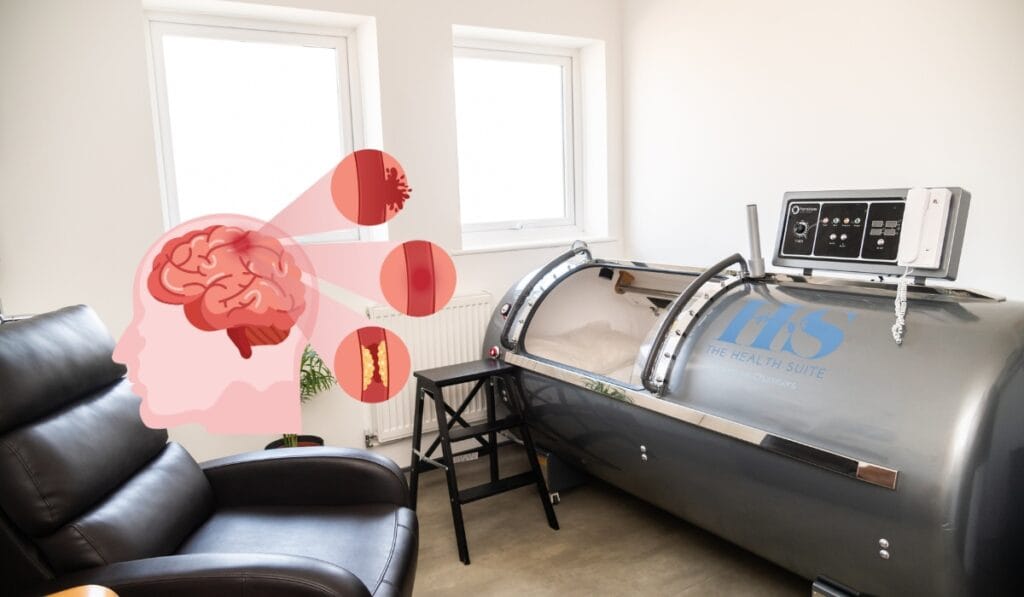Hyperbaric Oxygen Therapy (HBOT) involves breathing 100% oxygen within a pressurised chamber, which enhances oxygen absorption into the bloodstream due to the increased pressure. Traditionally used for conditions like decompression sickness, HBOT is now gaining popularity for treating a variety of other conditions, including stroke recovery.
What is a Stroke?
A stroke happens when the blood flow to a part of the brain is blocked or reduced. The brain needs a steady supply of blood to get oxygen and nutrients. When blood can’t reach a part of the brain, that area begins to die due to a lack of oxygen, leading to cell death, inflammation, and problems with energy production in the cells. Stroke symptoms depend on which part of the brain is affected, and recovery can vary. Some parts of the brain might remain inactive for years after the stroke.
Types of Strokes:
- Ischaemic Stroke: This is the most common type of stroke, making up about 85% of cases. It happens when a blood clot obstructs a blood vessel in the brain, similar to a pipe getting clogged.
- Haemorrhagic Stroke: This less common type happens when a blood vessel in the brain bursts, causing bleeding and potentially flooding the brain tissue.
How Does HBOT Work Post-Stroke?
- Boosting Energy Production in Cells:
- Research on rats post-stroke has shown that HBOT increases cellular energy, improves energy metabolism, and elevates levels of protective proteins that help reduce cell death and inflammation.
- Repairing Damaged Brain Cells:
- HBOT enhances the integrity of cell membranes, the protective barriers around cells, helping to stabilise brain cells and reduce the likelihood of further damage.
- Preventing Secondary Cell Death:
- Hyperbaric oxygen therapy (HBOT) can help stop further cell death by enabling healthy mitochondria from support cells to move to neurons, which are essential for brain function.
- Lowering Inflammation:
- Inflammation is a significant factor in stroke-related cell death. HBOT’s ability to reduce inflammation helps minimise secondary cell death and swelling in the brain.
- Reducing Nerve Cell Death
- HBOT influences several pathways that reduce apoptosis (programmed cell death) and preserve nerve tissue, owing to metabolic changes, an improved inflammatory response, and other discrete pathways.
Why Consider HBOT for Stroke Recovery? While HBOT is not yet a standard stroke treatment, its potential benefits are promising. It offers a non-invasive way to enhance the brain’s natural healing processes and improve outcomes for stroke patients.
Timing and Effectiveness:
- Early Intervention: HBOT is most effective when started soon after a stroke, ideally within 30 to 60 minutes, as it significantly reduces infarct size and improves outcomes.
- Later Intervention: While early treatment shows the greatest benefit, studies have demonstrated that HBOT can still be effective if administered later. Treatments within 6 to 12 hours post-stroke provide benefits with single sessions, and more extended or repeated sessions are required for treatments initiated up to 24 to 48 hours later. Beyond 48 hours, evidence is limited, though there are indications that aggressive HBOT regimens may still offer neuroprotective effects even up to 72 hours post-stroke.
- Chronic Stages: Small studies have shown significant improvements in patients in chronic stages post-stroke (from 6 months to 3 years after the initial stroke). For instance:
- A small prospective RCT found significant neurological improvements in patients who underwent 40 HBOT sessions over 2 months (5 days per week, 90 minutes each), even in chronic stages (6-36 months post-stroke). This suggests that neural plasticity can still be activated long after the initial damage.
- Another study involving individuals who had suffered an ischaemic stroke between one and two years prior demonstrated significant improvements in physical ability, walking speed, quality of life (including sleep), and cognition after 40 HBOT treatments over 8 weeks.
Conclusion
HBOT offers a potential therapeutic avenue for stroke recovery, providing hope for enhanced healing and improved quality of life even beyond the acute phase of stroke treatment.
Click here to learn more about Hyperbaric Oxygen Therapy and book an appointment.
References
- Aboul-Enein, F., Rauschka, H., Kornek, B., Stadelmann, C., Stefferl, A., Brück, W., Lucchinetti, C., Schmidbauer, M., Jellinger, K. & Lassmann, H. 2003a, “Preferential loss of myelin-associated glycoprotein reflects hypoxia-like white matter damage in stroke and inflammatory brain diseases”, Journal of Neuropathology & Experimental Neurology, vol. 62, no. 1, pp. 25-33.
- Aboul-Enein, F., Rauschka, H., Kornek, B., Stadelmann, C., Stefferl, A., Brück, W., Lucchinetti, C., Schmidbauer, M., Jellinger, K. & Lassmann, H. 2003b, “Preferential loss of myelin-associated glycoprotein reflects hypoxia-like white matter damage in stroke and inflammatory brain diseases”, Journal of Neuropathology & Experimental Neurology, vol. 62, no. 1, pp. 25-33.
- Efrati, S., Fishlev, G., Bechor, Y., Volkov, O., Bergan, J., Kliakhandler, K., Kamiager, I., Gal, N., Friedman, M. & Ben-Jacob, E. 2013, “Hyperbaric oxygen induces late neuroplasticity in post stroke patients-randomized, prospective trial”, PloS one, vol. 8, no. 1, pp. e53716.
- Hu, Q., Manaenko, A., Bian, H., Guo, Z., Huang, J., Guo, Z., Yang, P., Tang, J. & Zhang, J.H. 2017, “Hyperbaric oxygen reduces infarction volume and hemorrhagic transformation through ATP/NAD /Sirt1 pathway in hyperglycemic middle cerebral artery occlusion rats”, Stroke, vol. 48, no. 6, pp. 1655-1664.
- Liska, G.M., Lippert, T., Russo, E., Nieves, N. & Borlongan, C.V. 2018, “A dual role for hyperbaric oxygen in stroke neuroprotection: Preconditioning of the brain and stem cells”, Conditioning medicine, vol. 1, no. 4, pp. 151.
- Rosario, E.R., Kaplan, S.E., Khonsari, S., Vazquez, G., Solanki, N., Lane, M., Brownell, H. & Rosenberg, S.S. 2018, “The effect of hyperbaric oxygen therapy on functional impairments caused by ischemic stroke”, Neurology research international, vol. 2018, no. 1, pp. 3172679.
- Zhai, W.W., Sun, L., Yu, Z.Q. and Chen, G., 2016. Hyperbaric oxygen therapy in experimental and clinical stroke. Medical Gas Research, 6(2), pp.111-118.
Hyperbaric Oxygen Therapy (HBOT) is a medical treatment that entails breathing pure oxygen in a specially pressurised chamber, which enhances oxygen delivery to tissues, facilitating healing and reducing inflammation.

